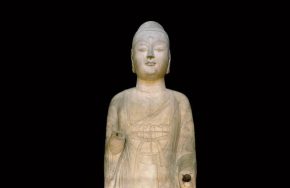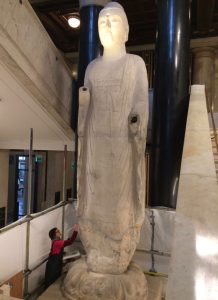Conservation of the colossal Amitābha Buddha at British Museum finished

The British Museum has finished conservation on the Amitābha Buddha, made possible by funding from the Bank of America Merrill Lynch Art Conservation Project. This colossal Buddha is one of the highlights of the British Museum’s collection, and is on public display in the centre well of the North stairs. Due to the challenges of physical accessibility, this marble statue which is more than 1,400 years old had not received full conservation treatment in over 25 years. Funding has facilitated its comprehensive analysis and cleaning for the first time in this period.
The British Museum has a world class team of experts in the Conservation and Scientific Research Department that is located in the new, purpose built facilities of the World Conservation and Exhibitions Centre. A team of conservators have used in-situ scaffolding to examine the Buddha’s surface condition, rectify dust build-up and discoloration through careful cleaning and carry out any necessary repairs. Wider renovations have improved the statue’s plinth and lighting conditions.
British Museum experts have for the first time, been able to fully read an inscription on the plinth of the Amitābha Buddha. The script names the Buddha’s original location in Chongguang Temple in what was then Hancui Village, Hebei Province, Northern China. It also names eighty members of the Yi-yi, a Buddhist society which was very popular during the northern dynasties, who originally patronized the building of this Buddha. These Buddhists also built two white marble bodhisattvas, one of which is now in Japan. The conservation department also undertook scientific identification of the wood used in the arms of the Buddha. Using scanning electron microscopy, the team identified the wood in the left arm of the Buddha as Ziziphus jujuba, jujube tree. Ziziphus jujuba has been widely cultivated in China for more than 4,000 years for its edible fruits, rich in vitamin C, which are often preserved or candied. The fresh fruits may be used medicinally.
The British Museum’s statue represents the Buddha Amitābha, the Buddha of Western Paradise, and stands at 5.78 meters tall on a lotus base. Its hands are now lost; originally, the right would have been raised, palm-outward in the Buddhist gesture of reassurance (abhaya mudra), the left lowered in the gesture of liberality (varada mudra). Carved in sharp relief with a flat back, the figure has a very solid form and drapery in flat folds, typical of the Sui period.
The Amitābha Buddha was previously displayed in the International Exhibition of Chinese Art, hosted at the Royal Academy between 28 November 1935 and 7 March 1936. The exhibition was proposed by a group of British collectors led by Sir Percival David, in light of growing international enthusiasm for Chinese art. It was organised in partnership with the Chinese Ministry of Education; more than 780 works were shown from the Chinese Government collection, alongside 3,100 pieces from 240 international collections. The Amitābha Buddha was a highlight of the displays, featured in the Royal Academy’s Central Hall. It was sent to the Royal Academy by CT Loo, a prominent art dealer of Chinese origin with Galleries in Paris and New York. Loo gifted the Buddha to the Chinese Government, who donated it to the British Museum in 1938 following the Royal Academy exhibition.
The British Museum previously worked with Bank of America Merrill Lynch in 2011, when, through the bank’s global Art Conservation Project, the Begram Ivories, twenty fragments of intricately carved and coloured ivory inlays, were conserved and put on display as part of the exhibition Afghanistan: Crossroads of the Ancient World. The pieces were conserved at the British Museum on behalf of the National Museum of Afghanistan and then returned to Afghanistan in 2012.
Jane Portal, Keeper of Asia at the British Museum said “The Amitābha Buddha is a powerful sculpture with a long history in China and a more recent story in the UK. We are extremely grateful to Bank of America Merrill Lynch for their support. Their Art Conservation Project has made possible both conservation treatment to beautify this important Buddha, and scientific research into the materials and production behind it. The physical accessibility of the statue has prevented this kind of comprehensive analysis and cleaning until now.”
